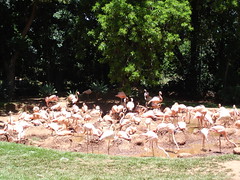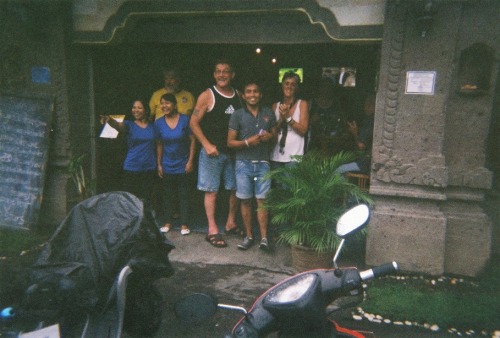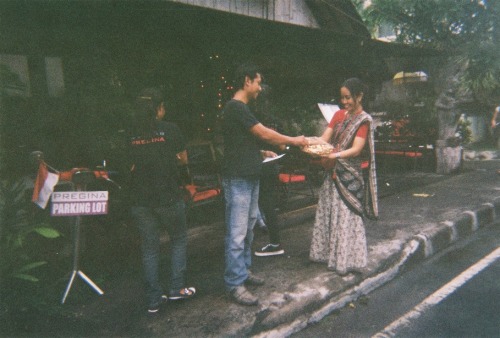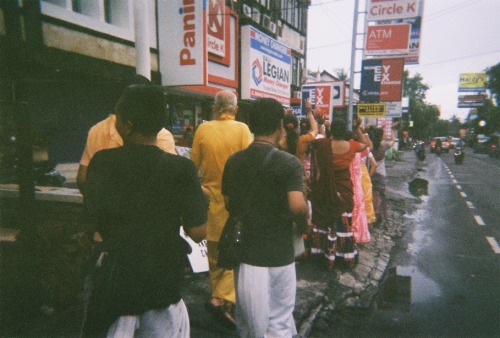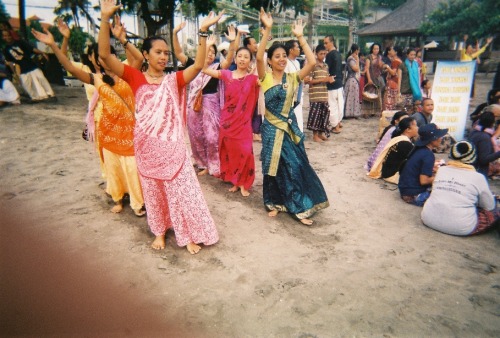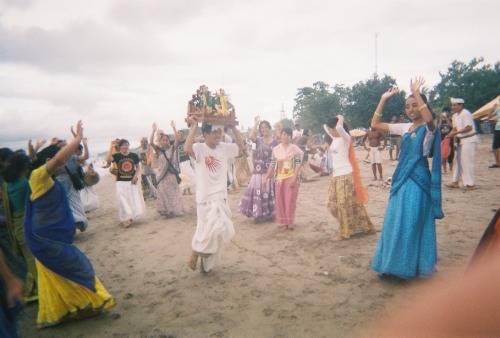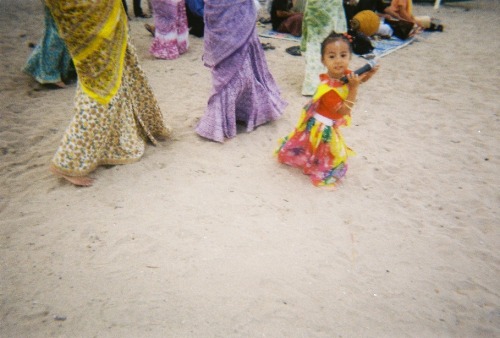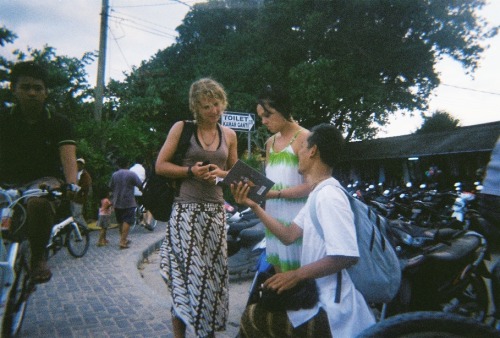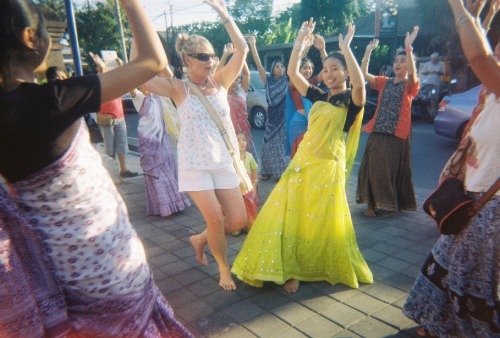
Here are the latest updates for you - Ekendra das, Alachua, USA: Happy Old Year
- H.H. Satsvarupa das Goswami (Ret.): Poem–Last Day 2011 | H. H. Satsvarupa Dasa Goswami | posted by admin
- H.H. Satsvarupa das Goswami (Ret.): Selected Writings | H. H. Satsvarupa Dasa Goswami | posted by admin
- Spiritual Scientist: Is the Bhagavad-gita an extremist book?
- Spiritual Scientist: Gita insights for New Year resolutions
- ISKCON Melbourne, AU: Today's Darsana
- Spiritual Scientist: Gita insights for New Year resolutions
- Mukunda Charan das, SA: 2011 in review
- Dandavats.com: Prabhupada Marathon in the UK
- Kurma dasa, AU: The Real KFC
- ISKCON Melbourne, AU: Jai Radha Madhava - Janananda Goswami
- ISKCON Melbourne, AU: Daily Class - Janananda Goswami
- H.H. Kadamba Kanana Swami: Honour, friendship and mercy
- Ananda Subramanian, Iowa, USA: Book Distribution 2011 - IV
- Japa Group: Japa Resolutions 2012
- Srila Prabhupada's Letters
- Srila Prabhupada's Letters
- Srila Prabhupada's Letters
- Srila Prabhupada's Letters
- Srila Prabhupada's Letters
- Srila Prabhupada's Letters
- Srila Prabhupada's Letters
- Srila Prabhupada's Letters
- Srila Prabhupada's Letters
- Srila Prabhupada's Letters
- Srila Prabhupada's Letters
- Srila Prabhupada's Letters
- Srila Prabhupada's Letters
- Srila Prabhupada's Letters
- Srila Prabhupada's Letters
- Srila Prabhupada's Letters
- Srila Prabhupada's Letters
- Akrura das, Gita Coaching: THE VALUE OF WRITING
- 16 Rounds to Samadhi Magazine, LA, USA: Priorities
- H.H. Bhakticharu Swami: Chanting Hare Krishna into the New Year 2012
- H.H. Bhakticharu Swami: His Holiness Bhakti Charu Swami Arrives In Durban, South-Africa
- Madhava Ghosh dasa, New Vrndavan, USA: The Mongoose and the Brahmin’s Wife
- One ISKCON.com: In The Local Temple
- H.H. Sivarama Swami: To day is our Prabhupada marathon festival and this is the morning’s kirtana
- Akrura das, Gita Coaching: MOTIVATIONAL QUESTIONS
- Japa Group: Greed For The Name Will Lead To Other Spiritual Greed
- Karnamrita das, NC, USA: A New Day, A New Year, A New Life
- H.H. Kadamba Kanana Swami: From light to darkness
- H.H. Sivarama Swami: Renunciation: You Will Tell Me When It’s Over, Right?
- H.H. Kadamba Kanana Swami: European kirtana fever hits SA
- Haricharana das, Indonesia: HARE KRSNA
- Haricharana das, Indonesia: It’s Only HARINAM But I Like It I said I know it’s...
- ISKCON News.com: Devotees Say Their Goodbyes to Yamuna Devi at Alachua Memorial
- ISKCON News.com: The Hungarian Parliament Passes A New Law On Religion
- Mayapur Online: Loving Separation: A Gathering to Honor Yamuna Devi
- Bhakta Chris, New York, USA: Faith House Manhattan Tour Bus: Experience Your Neighbor's Faith to Deepen Your Own
- Yoga of Ecology, Bhakta Chris, USA: Milk-Superfood or Hyper-Allergen?
- ISKCON News.com: Fight for the Yamuna River Reaches Indian Parliament
- Hari Sauri das, Mayapura, IN: In Memorium: Srimati Yamuna devi dasi ACBSP–Part three
- ISKCON Melbourne, AU: "Visit ISKCON Temple"
- ISKCON Melbourne, AU: Videos!!!
- Mayapur Online: A few words from Sacinandana Swami
- Gouranga TV: Rangadevi mataji kirtana
- H.G. Sankarshan das Adhikari, USA: Saturday 31 December 2011--Relishing the Beautiful Bhagavatam--and--I Can't Stop Chanting the Name of Allah
- More Recent Articles
- Search Planet ISKCON
- Prior Mailing Archive
Joining the Hare Krishna movement has, thank God, conferred me with the priceless boon of being convinced that I’m totally righteously exempt from observing “holidays” that aren’t inherently holy, and in fact have no meaning at all except some historical edict proclaiming such and such day to henceforward be such and such holiday, thus providing the working class with yet another excuse to get drunk, loud, and dangerous. From where I sit I can hear the unmistakable, unrelenting, hysterical cackles of the inebriated, the roar of the most perilous traffic of the year, as well as sirens, and the rumblings and cracks, near and far, of gunpowder blasts. My Internet didn’t work for crap when I was composing this or I’d have included some half-assed cranky research on who decided January first should be appointed the first day of the so-called “new” year anyway. What’s “new” about it? One digit on the calendar, that’s what. Or potentially a lot more digits on your auto insurance premium, or potentially one less digit if your blood whiskey level impairs your ability to light a jumbo firecracker and get rid of it quickly enough. All day today (New Year’s Eve) I’ve been wishing everyone “happy old year,” in true iconoclastic spirit, to cheer everyone the hell up about the relentless passage of time. I’m not feeling miserly or left out that I’m not pickling myself into an alcoholic stupor or blowing off fingers through improper handling of massive firework mortars. No. But what has changed besides a number? Why make a big deal? Maybe the observance of New Year’s is required for mourning another year gone, like funerals are mandated public events for establishing beyond doubt that someone is in fact dead.
Srila Satsvarupa Dasa Goswami Site sdgonline.org:
| | | 4:33 A.M. Poem for December 31 Sunset Pastimes, 6:00-8:36 P.M. Some fortunate boy decorates Krishna’s graceful limbs with the appropriate jewel-inlaid ornaments, and then ties gem-studded gold bangles on His lotus feet. Clutching the right hand of a dear friend in His left, Krishna slowly enters the house. After removing His jeweled slippers Krsna humbly [...] |
Srila Satsvarupa Dasa Goswami Site sdgonline.org:
| | | 6. “‘O Vaisnava Thakura, please be merciful to me. Let me serve you. By your grace I may control my senses. From you I will learn divya-jnana. Krishna is yours. I am simply running after you crying, “Krishna! Krishna!’ “Uttara prayed: ‘O Lord of Lords, O Lord of the Universe, O Soul of the Universe, [...] |
Question: When the Bhagavad-gita is revered by millions worldwide, why would anyone mistake it to be an extremist book? Is there anything in the Gita itself that lends itself to an extremist interpretation? (This article integrates and builds on two earlier articles on the battlefield setting of the Gita and its metaphorical interpretation. Readers who have already read those articles can skip them, if they so desire, while reading those two sections) Answer: The Bhagavad-gita, far from being an extremist book, is a book of wisdom and a message of love. It reveals divinity’s love for humanity; it is only our extreme disorientation from divine love that makes us imagine that the Gita is an extremist literature. Let us first understand the Gita’s essential message of love and then analyze some of its aspects that may seem to belie this message and may, if taken totally out of context and wildly misinterpreted, be seen as extremist. A Message of Love Krishna starts His message of love by enlightening Arjuna: we are all souls, spiritual beings (Gita 2.13), entitled to rejoice in eternal love with the supremely lovable and loving God, Krishna. All of us long for lasting love, but we seek it on the material platform that is inherently fleeing. The Gita’s philosophical wisdom of our eternal spiritual identity creates a lasting foundation on which we can build an edifice of love that the storms of time will never bring crumbling down. In the Gita, Krishna offers a concise overview of the various paths for spiritual progress – karma-yoga (the path of detached action), jnana-yoga (the path of analysis), dhyana-yoga (the path of meditation) and bhakti-yoga (the path of love). Simultaneously throughout the Gita (2.61, 3.30, 4.3, 5.29, 6.30, 7.1, 8.14, 9.26-27, 10.9-12, 11.53-54, 12.6-7, 13.18, 14.27, 15.19, 16.5, 17.26-27, 18.64-66), he drops clues that the path of love is the best path. As the Gita progresses, the clues become more and more explicit; the secret secret becomes an increasingly open secret till its emotional climax at its end (18.64-66), There, Krishna bares his heart’s love in a disarmingly sweet revelation, “Because you are My very dear friend, I am speaking to you My supreme instruction, the most confidential knowledge of all. Hear this from me, for it is for your benefit. Always think of me, become my devotee, worship me and offer your homage unto me. Thus you will come to me without fail. I promise you this because you are my very dear friend. Abandon all varieties of religion and just surrender unto me. I shall deliver you from all sinful reactions. Do not fear.” Thus, the Gita is essentially a revelation of divinity’s love for humanity as well as a love call for humanity’s reciprocal love for divinity. Potential Misunderstanding about the Gita Let us now look at three aspects of the Gita that are at times misunderstood. a. The Battlefield Setting of the Bhagavad-gita The Bhagavad-gita is sometimes misunderstood as calling for violence due to its battlefield setting. However, the Gita uses that setting to demonstrate that its call for transcendence is practical, responsible and dynamic. Let’s see how the setting serves these three purposes: 1. The practicality of spirituality: Many people feel that spirituality is too other-worldly and so is impractical or irrelevant given the urgent practical demands of this world. To address their concern, the Bhagavad-gita’s spiritual message is delivered on a setting that is eminently this-worldly and calls for the most urgent practical action: a battlefield. By showing how its spiritual wisdom solaced and empowered a responsible head of state, Arjuna, who broke down on a battlefield, the Gita illustrates poignantly the universal applicability of its teachings. If a person on a battlefield spared time for gaining its spiritual wisdom and found it relevant, practical and empowering, then no one needs to doubt the practicality of the Gita’s message and no circumstance needs to warrant relegating the Gita’s message to the “to be done later” category. 2. The social responsibility of spiritualists: While the Bhagavad-gita offers a message that can guide any individual in any circumstance to personal transcendence, peace and fulfillment, it also recognizes that people at large can benefit from its message only when the prevailing sociopolitical order fosters moral and spiritual integrity. When the ruling heads of state are morally and spiritually depraved, as they were before the Kurushetra war, assertive action is essential to prevent people from being exploited, abused and ruined. The Mahabharata sections preceding the narration of the Gita describe vividly - The multiple injustices and atrocities committed by the ruling heads of state, the Kauravas
- The repeated efforts of the victims, the Pandavas, to restore justice and morality in a peaceful way
- The utter disdain with which the Kauravas rejected all the attempts for peace, thus making a peaceful solution impossible
For those victimized by massive injustice, the Gita doesn’t condone a passive spectator role that reduces noble pacifism to impotent and suicidal utopianism. Instead, the Gita advocates pragmatic assertive action for protecting basic human rights. That violence should be the last expression of such assertiveness – and never anything other than the last – is illustrated by the exhaustive peace efforts that preceded it. The very fact that several globally acclaimed champions of non-violence like Mahatma Gandhi found inspiration in the message of the Gita demonstrates that violence is not its core message. Of course, those who find the battlefield setting discomforting have tried to explain it (away) in metaphorical terms, but such an explanation undoes the intrinsic pragmatism that makes the Gita’s message of transcendence so appealing. By delivering this message on a battlefield, the Gita illustrates that even those who consider life’s ultimate goals to be other-worldly have a this-worldly responsibility to contribute to establishing and protecting the moral and spiritual fabric of society. 3. The inner dynamics of spirituality: The metaphorical interpretation of the Gita’s setting is not wrong, but it best harmonizes with the overall spirit of the Gita when seen as a supplement to –and not a substitute for – its historical context. Then, the battlefield setting, in addition to its historicity, represents our internal consciousness that features the battle between godly desires and ungodly desires. Each of us needs to win this inner battle if we are to play our part in establishing moral and spiritual integrity in society and not let our ungodly attachments to selfish interests sabotage our godly aspirations for personal integrity. Even when our godly aspirations are outnumbered by our ungodly attachments, as was the case with the godly Pandavas fighting the ungodly Kauravas, the Gita’s setting conveys the morale-boosting reassurance that when we harmonize our godly desires with God’s will, then his supreme power will empower us to attain inner victory and self-mastery. To summarize, the Gita’s battlefield setting, when seen in its historical and philosophical context, reveals itself to be a call not for blanket violence, but for thoroughgoing spiritual activism. b. The Vision of God as Destroyer: The eleventh chapter of the Gita describes the universal form of God which emits blazing flames of destruction and devours all directions. Though such a conception of God may seem brutal and ghastly, it underpins a subtle but essential truth: the destruction and death that inevitably characterize the world are not outside the jurisdiction of God. God is not primarily the destroyer, but the restorer; when the temporary stands in the way of the eternal, as it does for all of us who are infatuated to the temporary and neglectful of the eternal, God destroys the temporary to make way for the eternal. Moreover, a careful reading of the full eleventh chapter reveals its essential import. Arjuna asks to see the universal form of God, becomes terrified on seeing the destruction therein and immediately changes his mind asking to be shown the beautiful two-handed form of Krishna once again. Just as the destructiveness of the universal form serves to re-direct Arjuna to the beauty of Krishna, similarly, the Gita teaches us, that the destruction and death that beset the world can serve to re-direct our heart to the eternality and the beauty of Krishna. c. Blunt Value Judgments: Some of us may be disturbed when we encounter in the Bhagavad-gita words that indicate strong value judgments: fool (mudha: 7.25), lowest among human beings (naradhama: 16.17) and so forth. To gain a proper understanding of why they are used, we need to contextualize them philosophically: Philosophical contextualization Value judgments emerge from values, which in turn grow out of a philosophy. If we go beyond the value judgments to the values and the philosophy, we will often find that the philosophy has a sense of its own. And once we understand the philosophy, we will find that its resulting values are not so different from our own. Then, with this intellectual framework in place, the value judgments will become at least intelligible, even if not acceptable. In other words, we need to judge the values before we judge the value judgments. Let’s therefore look beyond the value judgments to the values and the philosophy of the Bhagavad-gita. The Gita (14.4) advocates a remarkably ecumenical worldview in which God accepts as his own children all living beings – not just humans, but even animals and plants. Only recently and nascently has our political correctness started waking us up to animal rights. But thousands of years ago, the Gita confers upon all subhuman beings (or the more politically correct “nonhuman beings”) the spiritual right of integral and eternal membership in the family of God. Further, the Gita (4.7-9) describes that God so loves all his children that he personally descends to this world –not just once, but periodically again and again and yet again. Moreover, the Gita (9.32-33) by its universal and accessible gospel of devotion opens the doors of redemption for one and all, irrespective of caste, gender or other such worldly designations. This universality and accessibility of the Gita’s message has been appreciated by many eminent thinkers. Here’s Aldous Huxley’s quote as an example: “The Bhagavad-Gita is the most systematic statement of spiritual evolution of endowing value to mankind. It is one of the most clear and comprehensive summaries of perennial philosophy ever revealed; hence its enduring value is subject not only to India but to all of humanity." We may wonder: if the Gita advocates such lofty values, then why does it –and its teachers – hand out blunt value judgments to the godless? Open-minded, but not empty-minded The Bhagavad-gita presents an open-minded worldview that integrates all people, no matter how diverse their values, goals and paths. According to their level of spiritual evolution, the Gita assigns them an appropriate position on a universal continuum that extends downwards to total spiritual ignorance and upwards to complete spiritual realization. The Gita also offers them versions of spirituality customized to their levels so as to inspire and facilitate them to rise higher on the spiritual continuum. The Gita is broad-minded, but not empty-minded; it does not imagine vacuously that all levels on the spiritual continuum are the same. That’s why the Gita (16.7-20) disapproves unequivocally mindsets and lifestyles that violate one’s spiritual integrity and propel one downwards on the spiritual continuum. Thus, the Gita reveals a vision of a broad-minded God comparable to a compassionate doctor who is so extending as to open his clinic to all patients, no matter how sick, and to offer them treatment tailormade to their inclinations, no matter how reluctant they may be. At the same time, the Gita’s doctor doesn’t equate a mortally sick person’s condition with that of a vibrantly healthy person. Such equalization would condemn the sick person to perpetual sickness in the name of open-mindedness and would be a vintage example of empty-minded brainlessness. The Gita considers godlessness not as an intrinsic quality of the soul, but as an extrinsic infection acquired by unwholesome contact. According to the Gita, godlessness is a sickness for the soul, a sickness that is easily and thoroughly curable by the therapy of devotional service. Its value-judgments are like the exasperated outbursts of a caring doctor dealing with a suffering patient who stubbornly refuses to take the treatment. Seen in this light, the Gita’s value judgments are not expressions of condemnation, but of compassion. The Gita uses strong judgmental words like fools Srila Prabhupada was known to use the word “rascal” quite often, but his use follows in the compassionate not condemnatory spirit of the Lord Krishna, as is evident from the following quote, “The only concern of the devotees is that so many rascals are suffering in the concocted civilization of illusory sense enjoyment, how can they be saved? So our Krishna Consciousness movement is made for that saving the rascals.” Perhaps it is fitting to sign off with an apt quote of the Austrian philosopher Rudolph Steiner, "In order to approach a creation as sublime as the Bhagavad-Gita with full understanding it is necessary to attune our soul to it.” Attuning our soul to the Gita can be best done by understanding the Gita from those who have tuned their soul to it and are living its essential message. A prime example of a Gita teacher who was first and foremost a Gita liver and a Gita lover was Srila Prabhupada. His translation and commentary on the Gita, Bhagavad Gita As It Is, is not only the most widely distributed and read English commentary of the Gita, but is also the Gita commentary that has brought about the most transformative effect among its readers. By understanding the Gita from Gita lovers like him, we can not only dispel “extremist” misunderstandings about the Gita, but, more importantly, can also acquire essential understanding of the Gita. To conclude, while it is certainly important to defend the Gita so as to prevent it from being banned officially in any part of the world, it is equally, if not more, important, to understand the Gita so that we don’t ban it unofficially in our own lives by mistaking it to be incomprehensible or irrelevant. Let us therefore take the interest stimulated in the Gita by the banning controversy to deepen our own understanding of its message and to share that deepened understanding with others. Endnote: The metaphorical interpretation of scripture known as gauna vrtti (secondary meaning) as contrasted with mukhya vrtti(primary meaning) was reserved for the special contexts like those where: - The direct meaning would result in obvious absurdities. The standard example for this in Indian philosophy is the sentence “His house is on the river.” As no house can lie on the river, this has to be interpreted as meaning “his house is on the banks of the river.”
- The direct meaning could be supplemented – but not supplanted – with an additional meaning obtained by looking at the implied symbolism. Here are a few examples of the use of this approach by eminent Vedic teachers:
Madhvacharya is quick to emphasize that the literal understanding is the most accurate and the other understandings are only to gain additional, esoteric insight that is consistent with – and not contradictory to – the literal understanding. - The metaphorical understanding is also used by Sri Vedanta Deshika, a prominent teacher in the line of Ramanujacharya, with regards to the Ramayana and by Srila Bhaktivinoda Thakura, a pre-eminent preceptor in the Gaudiya Vaishnava tradition to which ISKCON belongs, with regards to Krishna’s Bhagavatam pastimes in his Krishna Samhita (Chapters 4-6) and also Chaitanya Shikshamrita (Part 5, Chapter 6).
- Srila Prabhupada himself used the metaphorical interpretation of the Kurukshetra war occasionally, as in his talk while giving initiations for the first time in America in 1966 at New York, as quoted in The Hare Krishna Explosion by Hayagriva Dasa.
“Krishna and Arjuna sat in the same chariot. But Arjuna knew that Krishna is the Supreme. We are also in a kind of chariot with Krishna. That chariot is this material body, and within the heart Lord Krishna is present as the Supersoul, witnessing all our activities. Even though He accompanies us within the material world, Krishna is never attached.” Paraphrasing Srila Prabhupada, the author further writes, “He then reminds us that we should never fret when confronted with adversities, for we should always know that Lord Krishna is driving our chariot.” Srila Prabhupada rejected time and again the metaphorical interpretation of the Kurukshetra war when it was used as a substitute for the literal interpretation, as a means to deny the historicity of the Mahabharata war, as a tool to explain away into non-occurrence the violence that occurred there.
The Bhagavad-gita (18.33-35) describes resolution or determination in the three modes of nature: goodness, passion and ignorance. The modes comprise subtle cosmological forces that exert psychological influences on us, thereby impelling us toward certain kinds of action. When our determination is impelled by the mode of ignorance, the force of destruction dissipates the resolutions even before they gets materialized, thus leaving them forever in the realm of daydreams. When our determination is impelled by the mode of passion, the force of creation energizes us to create a desirable change or achieve a cherished goal in our external situation. However, this force being motivated by the desire for change often runs out of steam when faced with the prospect of sustaining the change, leading thereby only to temporary, cosmetic improvement. When our determination is impelled by the mode of goodness, the force of sustenance empowers us to ongoing internal dynamism that brings inside-out change; it enables us to gain self-mastery and become more mature, responsible and principle-driven human beings, thereby subtly, smoothly and sustainably changing our externals for the better too. Determination in goodness is unbreakable and inexhaustible, for it is nourished by yoga practice that enables us to draw strength from the Infinite.

"O Brāhmaṇa Vyāsadeva, it is decided by the learned that the best remedial measure for removing all troubles and miseries is to dedicate one's activities to the service of the Supreme Lord Personality of Godhead [Śrī Kṛṣṇa]." (Srimad Bhagavatam 1.5.32) Here is the first darsana of the year 2012. By dedicating our activities to Lord Krsna may He remove all our material troubles and miseries and if He so desires, may He bless us with love of God.
The Bhagavad-gita (18.33-35) describes resolution or determination in the three modes of nature: goodness, passion and ignorance. The modes comprise subtle cosmological forces that exert psychological influences on us, thereby impelling us toward certain kinds of action. When our determination is impelled by the mode of ignorance, the force of destruction dissipates the resolutions even before they materialize. Thus our resolutions remain little more than daydreams. When our determination is impelled by the mode of passion, the force of creation energizes us to change our externals, but runs out of steam when faced with the internal change necessary to sustain the external change. This makes the change and even the resolution for the change short-lived. When our determination is impelled by the mode of goodness, the force of sustenance empowers us for inside-out change; it enables us to gain self-mastery and become more mature, responsible and principle-driven human beings. Our internal improvement then kindles external improvement subtly, smoothly and sustainably. What makes this kind of determination unbreakable and inexhaustible is the practice of yoga that enables us to draw strength from the Infinite. The yoga that most easily and effectively connects us with the Supreme is the yoga of devotion, bhakti-yoga. That’s why our resolution to stick to regular yoga practice underlies our ability to stick to all our other resolutions.
The WordPress.com stats helper monkeys prepared a 2011 annual report for this blog. Here’s an excerpt: The concert hall at the Syndey Opera House holds 2,700 people. This blog was viewed about 9,900 times in 2011. If it were a concert at Sydney Opera House, it would take about 4 sold-out performances for that many people to see it.
Click here to see the complete report.
 By Sutapa das By Sutapa dasBy all of your wonderful efforts I am happy to announce that the Prabhupada Marathon 2011 is the most successful since December 1998! I pray that we continue this sacred mission of distributing books to every corner of this country, and in this way increase our offering to Srila Prabhupada... an offering that will surely make him smile
Happy New Year everyone! You may (or may not) have heard of The Real IRA - well here's something equally revolutionary. Why not try The Real KFC -Kurma's Fried Cauliflowers. Crispy nuggets of cauliflower (or any vegetable, for that matter) fried in a spicy batter seasoned with Kurma's secret herbs and spices. Whenever and wherever I cook them, they are always a crowd-pleaser. Incidentally, I was calling Kurma's Fried Cauliflower KFC way before that notorious brand name, originally called Kentucky Fried Chicken, became KFC. I should have copyrighted the name back then. Yes I know - woulda, coulda, shoulda... 
Assorted Crisp Vegetable Fritters (Pakoras) Pakoras are popular spiced, batter-dipped, deep-fried vegetables that make perfect snacks or hors d'oeuvres. Ghee is the preferred medium for frying pakoras, although you can use nut or vegetable oil. The tradition of frying things in batter is popular throughout the culinary world. In Italy, there’s the delicious Neapolitan fritters known as pasta cresciuta, comprising of things like sun-dried tomato halves, zucchini flowers, and sage leaves dipped in a yeasted batter and fried in olive oil. The Japanese dip all sorts of things, including zucchini, eggplant and carrot into a light thin batter and serve the tempura with dipping sauce. In India, pakoras (pronounced pak-OR-as) are almost a national passion. Cooked on bustling street corners, in snack houses, and at home, the fritters are always served piping hot, usually with an accompanying sauce or chutney. The vegetables can be cut into rounds, sticks, fan shapes, or slices. The varieties are endless. Try batter-frying various types of vegetables. Cauliflower pakoras are probably the most popular, but equally delicious are potato rings, zucchini chunks, spinach leaves, pumpkin slices, eggplant rings, baby tomatoes, sweet potatoes, red or green pepper slices, asparagus tips, and artichoke hearts. Cook pakoras slowly to ensure that the batter and the vegetables cook simultaneously. Makes about 2 dozen pakoras. 2/3 cup each of chickpea flour, plain flour and self-raising flour, 2½ teaspoons salt, 2 teaspoons yellow asafoetida powder, 1½ teaspoons turmeric, 2 teaspoons cayenne pepper, 1½ teaspoons ground coriander, 2 teaspoons nigella seeds, 2 finely chopped medium sized fresh hot green chilies (optional), 2½ cups cold water, or enough to make a smooth batter, bite-sized vegetable pieces of your choice, ghee or oil for deep-frying. Combine the flours, salt, powdered spices, nigella seeds and optional green chilies in a bowl. Mix well with a wire whisk. Whisk in sufficient cold water to make a batter the consistency of medium-light cream. When you dip the vegetable in the batter, it should be completely coated but neither thick and heavy nor runny and thin. Have extra flour and water on hand to adjust the consistency as required. Let the batter sit for 10 to 15 minutes. Heat the ghee or oil to a depth of 6 – 7 cm in a wok or deep-frying vessel until the temperature reaches about 180°C/355°F. Dip 5 or 6 pieces of vegetable in the batter and, one at a time, carefully slip them into the hot oil. Fry until the pakoras are golden brown, turning to cook them evenly on all sides. Remove with a slotted spoon and drain on paper towels. Continue cooking until all the pakoras are done. Serve immediately or keep warm, uncovered, in a preheated cool oven for up to ½ hour.
(Kadamba Kanana Swami, Mayapur, November 2011) Lecture – Caitanya-caritamrta Part 4  Sanatana Goswami is meeting all the vaisnavas from Sri Caitanya Mahaprabhu for the first time. He has met Mahaprabhu in Benares and he has been instructed by Him, but he didn’t meet all of Mahaprabhu’s associates. Now for the first time, he meets Mahaprabhu’s associates. When he sees them, he offers obeisances to them. They give him honour, friendship and mercy, which is really interesting. They give him honour for his qualifications. They give him friendship, but also mercy because they have that association of the Lord, and therefore they can also give that mercy. It is very interesting as to how that relationship exists and how it is in a refined way…….and showing how vaisnava relationship is about, which is based on honour, friendship and mercy!
I went door knocking today although I will admit I was on an all-time low with my mind battling to muster the enthusiasm to distribute. I made a cold call to a person whom I thought would be interested in Krishna consciousness this afternoon, anyways the call did not go as per plan and to be honest I got a little hung up on that. My mind was thinking about that. Anyways the highlight of todays distribution is I distributed Bhagavad Gita flyers and cards. I also distributed Higher Tasterecipe book which I found people very eager to take versus the regular books. After few more books (although not much donation) I went home.
In addition to knocking on doors, this time I also placed books in shops. Actually I believe the smart box can distribute more books than me door knocking. So I placed two smart boxes in cafetarias. In my estimation, in one or two weeks the books are distributed. So I ordered small books and placed them in smart boxes. I am thinking of putting these smart boxes in more shops...lets see how that goes.
One other reason I am writing my experience of book distribution is to document my attempts so when I look back I can see how much effort was put in and what I can do better. Documenting is a crucial aspect of story telling. People like to hear stories and be inspired. I may not document all my book distribution efforts but hoping that if I do continue book distribution regularly then I may document it periodically.
So far I would say If you are a type of person who likes to meet new people, then book distribution is for you. You may not distribute books but just meeting new people in my opinion is exciting. When I say meet I mean the chance to have a discussion with new people. The person may not be interested in the books but by connecting with the person one can actually have an impact.
With that, I would also say this would be my last post for the year. I wish all my readers (although not sure if there are loyal readers) a very HAPPY NEW YEAR 2012.
I hope and pray your New Year starts on a good note and continue that way and perhaps you go one step closer towards Krishna!
Hare Krishna
Today was the last Japa Room of the year - we shared with everyone about our Japa Resolutions for 2012. It's very important to resolve to make positive changes in our Japa, not just for the New Year, but every single day of our spiritual lives.
Here are some of the very nice comments made.
"I pray that I can chant the Holy Names with Great Enthusiasm and Resolve."
"My resolution for the New Year is to dive more deeply into the Holy names and not just licking the outside of the Honey jar....I resolve to avoid offenses and to chant 12 rounds before I do anything else."
"Little by little I have been able to get to 16 rounds, today all at one go. I had to use many of the tools we have learned here in the Japa Room, especially chanting loudly"
"Iam going to take a resolution to chant 16 rounds only in the morning, starting at least before 6 am"
What is your Japa Resolution for 2012?
1967 December 31: "Let us go on for Krishna's satisfaction and for the benefit of the whole world. I am confident of my future hopes in the sincere students like you; & now if I die I will die blissful, the work will go on."
1968 December 31: "They are all mundane and have no entrance into actual spiritual activities. Superficially they pose themselves as great devotees, but we can feel their pulse; ultimately they are impersonalists."
1970 December 31 : "London is the most important city in the world and it is my desire to see it come to full blossom under your expert management. So if the two of you take charge I will be satisfied that things are all right there."
1971 December 31 : "If he comes, please try to save this foolish boy. I like him very much; unfortunately he pretends now as the incarnation of St. Paul. Try to save him."
1972 December 31 : "You have some desire to become famous Vaisnava and jagad-guru. But Vaisnava means no material desire, what to speak of sex desire. First become without any sex desire, then think famous Vaisnava."
1972 December 31 : "I am convinced that if you simply glorify Krsna and our books in the best descriptive manner, than anyone, no matter even atheist, they can be convinced to purchase one of our books."
1972 December 31 : "Act now or Krsna may take away this golden opportunity, being disappointed by our lack of enthusiasm and labor. George is now convinced of our movement, he will pay, so why the delay and difficulty?"
1972 December 31 : "Enthusiasm to serve Krsna is our price for entering into Krsna's kingdom. And maya is always trying to take it away - because without enthusiasm everything is finished."
1973 December 31 : "If the devotees become angry and leave then our work is defeated. We have to manage our men in such a way that they may bend but not break. After all, our work is purely voluntary."
1974 December 31: "Ultimately Ganesa Puja is not required, but if you have some sentiment to get the blessings of Ganesa in order to get huge sums of money for service of Krishna, then it can be done, but privately."
1974 December 31: "For the time being, continue doing what you are doing. I shall advise you. Whatever income you are getting, give to the temple. Go regularly to the temple and raise your child. There is no need of loitering here and there."
1974 December 31: "Stay with me, both of you are my disciples. It is my duty to guide you for spiritual advancement. Let us see what can be done for all the misunderstandings that have taken place."
1974 December 31: "So, make nice arrangement for all the devotees there. The principle is that we make propaganda for devotees to come. Don't ask any of them to go away. That is not our principle."
1974 December 31: "Sankirtana if it is not possible, never mind. Try to organize meeting and impress upon the people Srimad-Bhagavatam philosophy. This is also Sankirtana."
1975 December 31: "I am prepared to organize Gujarat by traveling village to village. You said that you could help me in this respect and also supply a car. So as soon as it is ready I shall accept, please let me know."
1975 December 31: "Thank you for your nice invitation card. Thousands of Caitanya Mahaprabhu temples may be established all over Australia so that I may receive one such invitation card at least every month."
1975 December 31: "We are getting perfect knowledge from Krishna through the disciplic succession, so our position is very firm. We do not have to manufacture anything new."
"Writing is a refined thinking."

Each one of us have unlocked potential to do good to this civilization, but we tend to limit ourselves to some rather mundane life purposes. It is due partly to an illusion that we have all the time in the world to live here on this planet. Actually, the truth is that life is short. Therefore, we must make spiritual realization our highest priority and take advantage of this human situation and get our priorities straight.
Article sent by His Grace Ramkinkar Dasa (Click on the pictures to discover the Treasure House Of India’s Spiritual Wisdom as presented by ISKCON Founder Acharya Srila A.C Bhaktivedanta Swami Srila Prabhupada) The hearts of the youths, beating to the transcendental sound vibrations of the Holy Names of Krishna: Hare Krishna Hare Krishna Krishna Krishna [...]
Sent by His Grace Ramkinkar Dasa (Click on the pictures to discover the Treasure House Of India’s Spiritual Wisdom as presented by ISKCON Founder Acharya Srila A.C Bhaktivedanta Swami Srila Prabhupada) Sirens of the Durban Metro Police escort broke the silence of the quiet Friday Midday, alerting over 150 devotees waiting in anticipation of the [...]
Once upon a time, there lived a Brahman by the name of Deva Sharma with his wife. His wife delivered a son and they were happy to have their first child. The Brahmin wanted to have a pet animal to protect the child which would also be a companion to the child. The Brahmin kept his proposal before the Brahmani. She found the proposal acceptable and the Brahmin went to bring a pet. Deva Sharma went round the village and after much toil, got a mongoose as an escort to his child. Brahmani didn’t like the idea to keep a mongoose for her child. But as the pet was already brought, so she accepted it. Now, both of them started loving the mongoose as their own child. Yet, the Brahmani never left her son alone because she did not trust the mongoose, fearing that it could harm her son. One day, the farmer and his wife had to go out of the house leaving the child at home. The farmer confirmed that the mongoose would take care of the child while they would be away. So, they left the mongoose and the child at home and went out. Soon after they left, a cobra entered the home. Finding danger to the son of the Brahmin, the mongoose attacked the cobra. They had a bloody combat and the mongoose succeeded in killing the cobra. After this, mongoose heard the footfalls of Brahmin’s wife and went at the door to greet her. Brahmani was trembled to see the blood stained mouth of the mongoose. She inferred that the mongoose had killed the child. Without a second thought, she threw a heavy box on mongoose and the mongoose died at the spot. Brahmani quickly entered the house to see her child and to her great surprise, she found her child sleeping quietly in the cradle. As soon as, she saw a snake bitten into pieces lying near the cradle, she realized that the mongoose had saved her child. The Brahmani was struck by grief that she had killed the mongoose that was like a sibling to her son. She cried loud at her hasty action. Lesson: Don’t pre-judge. Think before you act.

Answer By His Holiness Danavir Goswami: As you concluded, it is not easy to change the tide of twenty years. But if you want the real thing, nothing can stop you. I wouldn’t recommend getting too much into reform measures or campaigns as it may take more out of you than it replaces. 
1. Do youhave someone who inspires you the most to take up and persist in your key roles in life?
2. Do youread every day to learn how to become a better devotee and professional?
3. Areyou ready to be patient until people you assist are sufficiently grown up and developed so they canstay on their own feet?
4. Do yousee people in terms of their potential or in terms of their faults?
"I like to hear the truth, that our destination depends on our sadhana and bhajana. It makes me think that my remedial practice of japa is right. It is the way to go to the topmost stage because I first have to attend to the crucial deficiencies in my foundation. Greed for the name will lead to other spiritual greed."
Begging For The Nectar Of The Holy Name Satsvarupa dasa Goswami
(this blog is recorded on the full page: quick time player needed) Rising early, with spiritual contemplation is a real gift to our true self, though it requires discipline by going against the world’s current to stay up late being “entertained,” pushed to have external focus busily distracted, acquiring gadgets not questioning life’s purpose. Do we own our house, car computer game, smart phone, packaged food, or do they own us? read more
 (Kadamba Kanana Maharaja, 29 December 2011, Munich, Germany)We are coming from South Africa- from summer into winter. I’m not sure what is worse- the cold or the darkness! It’s so dark, shew! What a shock, coming from all that bright light and the sun and the early mornings… so that is only a comparison between Africa and Europe. Can one imagine coming from the effulgence of the spiritual world into the darkness of the material world? How dense is the darkness of the material world! How thick are the layers of ignorance! How much is the living being covered by layers of forgetfulness! And we, who are somehow or other awoken to Krsna consciousness, can be compared to a clouded sky which sometimes has a little hole in the deck of clouds which appears and a little beam of light enters through, before the hole is again covered by a grey cloud…How deep is our Krsna consciousness…?
SRS: Braja Sevaki dd on women managing the latter year consequences of youthful renunciation. http://bit.ly/uIULEC
Harinama – A powerful preaching tool in South Africa In order to promote the December book marathon in South Africa, HH Kadamba Kanana Swami invited 3 stalwart sankirtana devotees from the Czech Republic to tour the country with him during his recent visit there. These devotees were Vishnujana, Gourakaruna and Prahlad; each uniquely talented in their service. 
Vishnujana is the drummer of the team and is expert in getting people to chant and dance; he is what you would call the ‘life of the party’. Gourakaruna is the flamboyant book distributor with a specially tailored bicycle that he carries around the world with him. This bicycle is equipped with a bag of books, a pair of kartalas, a vuvuzela (a traditional African horn), boxes of incense and is adorned with a flag of Hanuman. It bears resemblance to a transcendental chariot. Prahlad is the kirtana leader and accordion player who sings beautiful melodies continuously for hours. 
The devotees traveled from Pretoria to Durban and then to Cape Town. In each of these cities, they would go out daily to the surrounding areas doing harinama and distributing books all day. In Durban, they aligned forces with HH Mahavishnu Swami and rocked the crowds at the beach. In Cape Town, they attracted hundreds of tourists in the city centre and thousands of locals on the beach with the Holy Name. Apart from their independent endeavours, they participated in many programs with Kadamba Kanana Swami and spiced-up the lively nature of the kirtanas. It was a wonderful month exhibiting the pastimes of Lord Caitanya. Mercy was distributed freely and without discrimination. Here are some photos and videos displaying these adventures however they do not do justice in capturing the true spirit of these glorious sankirtana warriors! kīrtanīyaḥ sadā harih Enjoy! Harinama in Hammanskraal Beach Harinama in Durban Part I Beach Harinama in Durban Part II MVSwami on stage Shop Harinama Part I Ecstatic MVSwami Tune Harinama in Cape Town Can’t view the slidehow below? Just visit flickr!
 | Harinama SA |
108 fotos | 804 vistas Los elementos son del 30 de jun 2005 & al 24 de dic 2011.
HAPPY NEW YEAR 2012 EVERYONE~HARE KRSNA
It’s Only HARINAM But I Like It I said I know it’s only Harinam but I like it, like it, yes, I do Oh, well, I like it, I like it. I like it…
By Madhava Smullen for ISKCON News on 31 Dec 2011  | Around 200 devotees attended a memorial service for Yamuna Devi, an ISKCON pioneer, award-winning chef and much loved friend and guide, in Alachua, Florida on Tuesday December 27th.
|
By Krishna-lila Dasi for ISKCON News on 31 Dec 2011  | On the 30th of December, the Hungarian Parliament passed the new religious law that is in lieu of the one cancelled by the Constitutional Court earlier in December. The next two months will still remain crucial in defining ISKCON Hungary`s future for decades.
|
Many years ago, while in Vrindavan, I expressed to my spiritual master my difficulty in engaging in some elements of the process of devotional life. When he asked why, I explained how I was only inspired to do something not out of duty, or because I was told, or because it was required, but that I felt it had to come from the heart, it had to be done out of a deep, heartfelt desire to want to do it. It had to be for love. read more
Click through the slideshow to look at photos from the Faith House Manhattan Tour Bus:
We are coming to a realization that religious zealots cannot be fought with indifference. Extremists of all nationalities and religious persuasion feeding on prejudice, legislating exclusion, and resorting to violence cannot be prevailed upon by people with less passion. Telling them to "cool down" and to "be moderate" will not do it. We must allow fires greater than theirs to arise. Our passion for a whole and interdependent word must rise above their passion for a segregated and zero-sum world.
In Faith House Manhattan, a non-profit inter-religious "community of communities," we believe that the time of isolated faith is over. We believe that to know who I am, I must also know who you are. For three years now we have hosted more than 60 Living Room gatherings where people can experiences the practices of another religion (or path, including atheism). We invite all to join our "co-laboratory" of interdependence: "Experience your neighbor's faith, deepen your own."
Our call is to get radical. Very radical. We hold that in today's world, religious people have to remap their reality to include -- in tension and in gratitude -- 'the other.' While our ancestors may have fought for independence, ours is the great struggle for interdependence. 'The other' is not over there, but all around us. While we have been conceiving of the world in vertical terms (whose party is better, whose institution is larger, whose nation is stronger, whose god is bigger), the world is becoming increasingly horizontal, and wonderfully so. Can we learn to be a part of the whole?
This past year, Faith House started a new program with four religious communities in Manhattan, who were part of a "Tour Bus" with reciprocal visits to each of our main religious gatherings. We brought people together to trespass imaginary boundaries while preserving the real ones. From an experience of worship at a Hindu temple, to a Jewish Shabbat service, to a Sufi Zikr, to midweek "Space for Grace" at a major Protestant church -- either as "Interfaith 101″ or an opportunity for seasoned pilgrims to be hosts or guests in their own setting -- this seven-week adventure was a unique New York City experience.
One of the participants, Bhakti Center monk and teacher, Chris Fici, summarized the experience this way:
Experience Your Neighbor's Faith, Deepen Your Own. This is a personal revelation a lot of us have shared recently on the Faith House Bus Tour, as the different sounds, colors, tastes and waves of devotion we have experienced together in our different houses of faith have made a deep communal resonance in our souls.
Too often (at least from my own perspective) our own practice can become caught in the mechanical. Living as a monk, in an intense and insulated environment, I often see how my consciousness during our morning meditation is directed towards how tired I am, or how I might be upset with this monk or that monk. The beautiful essence of our prayers and singing and dancing together remains lost to me.
As I was soaking up the whirling sanctity at our wonderful Bus Tour event at the Dergah of the Nur Ashki Jerrahi Sufi Order, the pain of my own disconnection in my own practice became manifest, and that void was quickly filled by the wonderful and mystical people I saw around me, deeply absorbed in the love and vision of the Divine. I came to realize that what they were experiencing was something I had access to every day, if I chose to. I saw very clearly how we were all pearls on the same thread of God's mercy. I returned to my own community and practice with a sense of renewal that has stayed with me ever since.
The interfaith experience is very important for me, and I think for all of us as a common human family. The turbulence of our age calls for a communication between peoples of faith that transcends our superficial differences and allows us to drink from the immense well of wisdom God has given us, to give solace and take profound action to help cure our shared ills.
This turbulence also calls from us a tremendous maturity from our humility, from a recognition that we cannot possibly have the exclusive answers, that the pieces of the puzzle we need come from our brothers and sisters in faith. In Thomas Merton's journals of his final and fateful journey to India and Indonesia, where he breathed deeply of the eastern faiths that had always intrigued and inspired him, he related a realization in this regard that has deeply touched me.
He says that those who are mature in their faith are able to enter into the experience, philosophy, and practice of another faith and gain a practical wisdom which they can take back into their own renewed and strengthened spiritual life. This is the essence of my own personal adventure in interfaith. To be able to see of and hear of and speak about and taste of and move within the common thread of our faiths together is one of the most profound experiences I have ever had in my life. It links me to the maturity needed to answer the spiritual call of our time, and I imagine it may do so for you as well.
I am always eager to point out to others that New York City is a deeply spiritual place. I want to encourage others to develop the vision of the great rivers of faith which run through this town, which are not always visible beyond the surface tumult and loosely organized chaos.
When you come to New York City, you can enjoy a Broadway show, walk the Brooklyn Bridge, check out that special night club you found on Google, enjoy this gastronomical paradise with more than 4,000 restaurants, but don't miss the rich undercurrent of spirituality you can find at every corner. The many religious traditions can help you understand yourself, and perhaps rekindle a passion for your own faith, an encounter that will change you forever. You might even come back to your home and do something radical like taking time to understand the faith of the other, whose life is now inextricably intertwined with yours.Read articles and reflections about each stop on the Faith House tour here.
In my time as a health professional I don’t think there is any other food i've come across that has more controversy and conjures up such a polarity of opinions as Milk. Although an ongoing source of confusion for years, a client’s recent inquiry over milk gave me the impetus to write this article. I will state that my purpose is not to convince anyone to drink milk or not. This is intended to give a brief, but thorough understanding and accurate depiction as to why such polarities of opinions exist. Are both statements right? Well read on and find out… Milk - super food or hyper allergen?
Now milk goes way back as a Superfood- According to Ayurveda (the “science of life”- A 5000 year old healing system with roots in India) milk has special and unique nutrition unlike any other food- It is said to balance emotions and help balance all the “doshas." Acclaimed Indian Swami Srila Prabhupada stated that milk helps to form and maintain our “finer brain tissues,” which is a boon in the quest of self realization- Now that’s quite a statement if you ask me... On the other side of things, (occurring in the more recent years) milk has been branded a health risk- linked to cancer, diabetes, allergies, and digestibility issues.
The main issue to understand when deciphering information about dairy is that the negative statistics about milk are being compiled from a product that really isn’t milk in its true form. Pasteurized, homogenized corn, soy and/or grain fed milk is not really milk anymore. It falls into the category that Michael Pollan (Omnivores Dilemma) describes as “edible food like substances.” The entire structure of the product becomes changed and compromised- This leads to the digestibility issues and health concerns. The digestibility issue is usually blamed on the pasteurization (heating of the milk at high temperatures to potentially kill off any “pathogens”), thus destroying vital enzymes during the process that would allow proper assimilation of the milk. The greater issue is that during the heating/pasteurization process the fragile milk proteins are drastically changed, which leads to deeper digestibility issues. The “milk” becomes a foreign substance and our body mounts an immune response to it.
Homogenization breaks the fat molecules down to such a micro level that they can’t be properly assimilated by our body- It alters the enzymes and fats so that they enter the bloodstream and can “scar” the arteries, leading to cholesterol buildups. If that’s not enough, there is the antibiotics and growth hormone issue that also accompany conventional supermarket milk. Organic milk may be antibiotic and growth hormone free, but still runs into the same issues when it’s pasteurized and homogenized. Also, the nutritional and health value of the milk changes when the cows are grain, soy, and corn fed (which much of the organic milk is). This is not their natural diet and it shows up in the quality of the milk.
This is the crux of the issue in regard to conventional, pasteurized milk. Emphasis on the words conventional andpasteurized. Where the misinformation occurs with milk is when people start making blanket statements: “Milk is linked to allergies, cancer, contains antibiotics etc..” This is true for conventional, pasteurized milk, but doesn’t have anything to do with real milk- I just want to make this distinction clear...
Now for the other side of things: pure, grass/pasture-fed cows milk is a whole other story- It is a raw, living, vital food. For as damning as conventional milk can be for our health, raw milk is equally as healthy. Many consider it the “wonder tonic” that the Ayurveda deems it, and the results are there to back it up. Raw milk has been known to reverse chronic disease and maladies from asthma and eczema to irritable bowel syndrome. Ingesting in its pure, natural state ensures that crucial enzymes and beneficial bacteria (such as lactobacillus) are intact which aids in proper digestion. In fact most people who have digestibility issues with conventional milk do just fine with grass-fed raw, real dairy. People all over the world have sworn by raw milk and dairy for helping them to regain their overall health and vitality back. Some indigenous people/cultures (who tend to be the healthiest people in the world) revere raw whole milk and dairy products as a “sacred food” as they know it to be a cornerstone to their robust mental and physical health, well being, and good fortune.
The formula for proper raw milk has to be that the cows are grass fed, and of course the farmers are conscientious and clean. Raw, grass-fed milk in its pure state has natural enzymes (its own “defense system”) to protect it from pathogens. There is no need to process it to protect us from any contaniments (Pasteurization also kills the pathogen fighting enzymes). Now there is a reason why other dairy products are pasteurized- Even organic, grain-fed milk could have contamination issues-It is processed for your protection.
Sale of raw dairy products are now illegal in most states (but interesting how you can buy Twinkies and an artificially sweetened mega energy drink). If you decide to try to go the raw route, there are buying clubs you could get involved with. Just look online, ask around, and do the research. There are also some grass-fed (but pasteurized) milk options at health food stores that some do fine with.
I personally avoided most dairy products for many years- Though the benefits of milk were tied into my Yoga culture/lineage and I heard from top health professionals about the deep health advantages of real dairy for quite some time. For these facts, when I finally had the ability to have access to them, I gave them a try.
In my training, I have noticed a distinct difference while starting on a raw heavy cream (a fairly recent addition). Raw cream is dense in fat soluble vitamins (which regulate hormones, metabolism, and assist in a healthy immune system), healthy fats for proper metabolism, Congelated Lineolic Acid/CLA and CoQ10. I treat it more like a “supplement” than a food (as consumption consists just of a couple spoonfuls a day), but it has made it into my routine and I feel great.
*Bonus Section: Again, this article isn’t written to dissuade you from, or sway you into consuming dairy products- We respect all stances, but it isn’t a forum to get into personal, ethical, or moral issues on dairy consumption. Its purpose is solely to distinguish the very distinct differences between conventional milk and raw real milk- We hope you understand the facts a little better now, and the choice is yours. Now for those who choose not to drink milk, there is a whole “milk alternative” industry vying for your business for what you’re going to put on your cereal or in your coffee. Some products try to tout as a “healthy alternative” (from conventional), but realize that none of them have any real health value.
Once something is put in a carton or can and on a shelf, it’s been pasteurized and has had the “life” sucked out of it. I would advise to stay away from any soy alternatives for the myriad of issues associated with conventional soy in general. I am not crazy on the rice milks either (for the general “dead” reason) along with the sweeteners and oils they put in with them. If I had to choose any, I would say go with an unsweetened almond milk- Best choice yet, learn to make your own live, raw almond milk with soaked almonds. It takes a little time and energy, but a wonderful and delicious healthy choice.
Adam is a Reiki Master, certified Health and Lifestyle counselor, Licensed Massage Therapist, 20 year practicing bramana initiated Bhakti Yogi, Spiritual advisor, visionary, jock and veteran of the “hardcore punk scene” all rolled into one. Adam is the founder of Omkara World and produced the mind/body fitness DVD “Intelligent Fitness."
By Madhava Smullen for ISKCON News on 31 Dec 2011  | After a whole year of active protesting and lobbying by sadhus, devotees, and environmentalists, it looks like the fight for the Yamuna River is finally reaching its peak, with the issue snowballing its way into Indian Parliament on December 18th.
|
I will finish this small attempt at appreciation of Yamuna devi’s unlimited qualities and character with a few photos and recollection of the last time I saw her personally in 2010 at Saranagati farm in Canada. 
Akrura prabhu, the Vancouver temple president invited me over in late May 2010. I hadn’t been there since 1994 so I was overdue for a visit and looking forward to it. But high on my agenda was a trip to Saranagati, a well-known but remote outpost of Krsna consciousness and home to some distinguished residents. Apart from fulfilling a long standing curiosity about the farm, I was excited because I would be seeing Yamuna. In fact I had written to my wife Sitala “I am only going because Yamuna is there.” We had had the immense pleasure of hosting Yamuna in Mayapur for two months in the flat next to ours during the winter of 2009 so my visit to Saranagati was a kind of reciprocation.  
Here’s the report I sent to Sitala on May 30th 2010, two days after. It sums up nicely the visit: “The trip to Saranagati was well worth it although I was only there half a day and one night. Its a long drive of 4 hrs. I stayed at Kala and Yasomati’s house for Lord Nrsimhadeva’s appearance. They invited friends and relatives and about a dozen people turned up. It was low key but still very enjoyable.” “Next day we drove up to Sarangati with Krsnadas, Kala’s son, and his Iranian girl friend Asadah. It was a long drive through continuous mountains, with very impressive country side of mainly pine and fir forests and deep river gorges. The area where the farm is doesn’t look very good, a kind of high desert region, but once you climb the dirt road up the mountain side, you come to a plateau and about 3,000 acres of land and forest owned by ISKCON and the devotees. Its quite like a shangrila.”  
“There are about 20+ private houses scattered within 2-3 kilometers of each other. We had lunch with a very nice devoteeYoginatha prabhu and Vishakha came to join us. Yadubara is down in LA for the Prabhupada festival.”  
“Then we visited the school. Kar and Radha have had a beautiful little boy just three weeks ago, and they run the school.”    
“For convenience they have moved into a large room in the school building. They have about a dozen girls and one boy currently in the school and a few couples with children are about to move there. It was a nice set up, very Krsna conscious, and all the kids, who range from about 5-16 yrs. are very sweet, innocent and eager to hear about Srila Prabhupada. I spoke for about 15 mins.” “Then we went off to Yamuna’s. I was surprised to see a modern looking bungalow.  
“I had heard about its straw bale construction and was expecting something a little crude, but its a well designed attractive house. And the interior is exceptionally beautiful, not so much because of its architecture but more because every inch of it oozes bhakti.”  
          
  
 
“Yamuna and Dina (who arrived back from Florida just as we were leaving) 
have decorated every nook and cranny with beautiful expressions of their love for Sri Sri Radha Banabihari. Yamuna is such an artistic and thoughtful person, and her attention to every little detail comes shining through.” “We spent a couple of hours with her, it was a delight. She is such a deep, sober and good hearted devotee. She was very happy to see me and we had an extremely enjoyable meet. It was worth the trip just to see her.”  That was the last time we met personally. Late in 2010 she became seriously ill, had to go to Mumbai for treatment and ended up leaving Saranagati, never to return. She and Dina moved south to Melbourne Beach Florida. In mid-August this year while I was on tour in Spain, I was thinking about her a lot and wrote to ask her how she was faring. I received this letter in response on Lord Balarama’s appearance day, my last communication with her: Dear Hari Sauri Prabhu, Pranam Dandavats Sree Balaram Mahotsava keejay How auspicious to hear from you on this sacred eve. Thank You for thinking of me at all, what to speak of lately. Truth be told, think of all three of you often–I have many photos Rama Devi gave me of you, your daughter’s initiation, and 1500 photos of archa vigrahah in Mayapur dham on my screen saver. So you are never far out of mind. Well the free fall that began nearly a year ago ended two months ago tomorrow, when on June 13th we moved into our eighth floor. furnished beach front condo rental. We have named the place Melbourne Beach-Puri-by-the-Sea. It’s a year rental for now. No sale of our Saranagati ashram. In the last decade, only two families moved there, but more moved out. Time will reveal that one. Cannot even consider our next move until we sell that ashram. At any rate, here we are in a clean environment with running water and enough electricity and we feel blessed to be here. Krsna so very kindly gave us a swift kick to remove us from Saranagati and place us elsewhere. This particular dham is most conducive to healing and rejuvenation, and we are deeply grateful for it. Taken time to settle in, and so far, engaged almost exclusively chanting and reading and physical rejuvenation and serving Their Lordships. Here is a photo of Radha Banabehari taken this morning in the small alter environment we made for Them in a smallish temple room; 
Srila Prabhupada; 
a snap Dina took this morning of ‘turtle tracks heading seaward’ and her friend the blue heron crane on the steps to the beach,  
and a snap I took of sunrise from our porch. 
Think you get a peek into our peace and opulence in our lives. My health: Exercise in the pool daily at dawn (Dina on her beach japa walk) before morning Bhagavatam class; too good for words. Starting a two week liver cleanse day after tomorrow as pre-op for a minor laproscopy surgery August 29th. So in between Janmastami-Vyasa puja next weekend, heading up to Gainsville three times for doctor appointments and tests. All in all, my health is slowly but very surely improving for the better, gaining mobility and strength, as is Dina. Got my research materials sent down here from Saranagati, and plan to begin writing in September. Dina will soon begin editing a book from the Radhanath Swami camp. Back at you: how are all of you? Health? Any new book volumes out from you? Sitala still in Poland giving KC as only she can do? Your daughter? Saw an ecstatic Kirtan online with Madhava at Woodstock. Your always aspiring servants. Yamuna and Dinatarine I don’t know if Yamuna did start writing again. Her book was the one most devotees were looking forward to reading. Now she’s gone, heading off into the sunset of Melbourne Beach and into the eternal sunshine of Goloka Vrndavana to serve her beloved Radha Banavihari and Srila Prabhupada. She will be sorely missed. I hope to have the privilege to see you again sometime Yamuna devi.

Here is an interesting invitation by the 'Weekend Notes' website to visit out Melbourne Hare Krsna Temple.

This link will connect you to the latest videos of Russell Prabhu, namely: - Seminar: From Sraddha to Prema by Sankarsana Dasa Adhikari - Christmas Harinama at Father Bob's Church - Kirtan by Vasudha Priya Mataji
Following the amazing success of the First International Kirtan Mela in Germany, we are happy to announce that the Kirtan Mela will now also come to Sridham Mayapur, just before Gaura Purnima- Feb. 22-25. We will again have 12 hours of uninterrupted kirtan for four days, led by the most talented kirtan leaders of our movement. read more
A daily broadcast of the Ultimate Self Realization Course Saturday 31 December 2011 The Supreme Personality of Godhead, Lord Sri Krishna, and His eternal consort, Srimati Radharani are enjoying transcendental pastimes in the topmost planet of the spiritual world, Sri Goloka Vrindavan. They are beckoning us to rejoin them. (Click on photo to see a larger image.) Our Mission: To help everyone awaken their original Krishna consciousness, which is eternal, full of knowledge and full of bliss. Such a global awakening will, in one stroke, solve all the problems of the world society bringing in a new era of unprecedented peace and prosperity for all. May that day, which the world so desperately needs, come very soon. We request you to participate in this mission by reviving your dormant Krishna consciousness and assisting us in spreading this science all over the world. Dedicated with love to ISKCON Founder-Acharya: His Divine Grace A.C. Bhaktivedanta Swami Prabhupada, our beloved spiritual master, and to you, our dear readers. For Transcendental Association Connect With Other Members of this Course. Join this Conference: http://groups.google.com/group/sda_students Help Popularize Our Message By Liking Today's Thought on Facebook: Today's Thought: Relishing the Beautiful Bhagavatam uploaded from Melbourne, Australia There's no literature like the Srimad Bhagavatam anywhere in the vast universe. It's 18,000 verses are an unlimited ocean of honey oozing out of its pages to fill the ears of the conditioned souls with the profound enlightening teachings of how to gain the intimate personal association of the Supreme Personality of Godhead, Lord Sri Krishna in His transcendental pastimes in the Spiritual Sky. The icing on the cake is the Bhagavatam's 10th Canto which describes in detail Krishna's transcendental pastimes in Vrindavan. Srila Prabhupada instituted the Srimad Bhagavatam class as a regular daily function in the ISKCON temples all over the world. It was the first canto of the Srimad Bhagavatam that he brought with him when he first came to America in 1965. For those who follow Srila Prabhupada's instruction to study the Bhagavatam daily every morning is a fresh, exciting experience of going deeper and deeper into the sublime ocean of the Srimad Bhagavatam. Sankarshan Das Adhikari Srimad Bhagavatam Lecture Melbourne, Australia 29 December 2011 http://www.backtohome.com/images/2011-Fall/Melbouren_Bhagavatam.JPG Answers by Citing the Vedic Version: Question: I Can't Stop Chanting the Name of Allah Please accept my humble obeisances at your lotus feet. All glories to Srila Prabhupada. I thank you so much for sending me the Ultimate Self Realization Course. I am very grateful to you. I am a Sufi Muslim. In my beginning I was lazy in chanting alone or in weekly kirtan. (Sufism is similar to bhakti yoga in that we also chant the name of God.) For many, many years I was fighting in martial arts. Once an opponent kicked me on my right jaw. I was literally knocked out and was in a coma. After that I understood that I had gotten a near death experience. Making a long story short, I encountered angels or luminous beings, and their chief of higher rank said to one of the angels, Tell him to go back on earth because his time for death has not come yet, and tell him to chant a lot the name of God. So the angel told me to go back in earthly life and advised me very earnestly to chant a lot the name of God. The angels seemed to know my life very well. So being a Sufi Muslim my main mantra is Allah. After that I used to do with discipline mantra japa for hours until my knees are severely hurting. I still have pain in my knees now. Our way is to say loudly from the chest, Allah Allah Allah. It is in Arabic language the greatest name of God Almighty. I chant this name of God loudly when driving, walking, or even watching the news on the TV. As my spiritual master is no longer here on earth I will ask this question of you: My mantra is running itself without any effort. For example, in many cases or even in board meetings at work my tongue is chanting the name of Allah loudly. And when my colleagues look at me in a strange way I feel ashamed. So I bite my tongue, but my mind is chanting it instead. It seems I am here and not here. What does this mean? And does the chanting reach the atma? Sincerely yours, Ali Answer: You Are Fortunate Indeed That you have such a taste for chanting the holy name of God means that you are a very, very fortunate being. You are feeling your presence in the material world and at the same time realizing that you are actually from a different world, the spiritual world . This is very nice. Chanting the Holy Name of God brings you back to your original spiritual nature as the atma, an eternal spirit-soul. And this chanting connects you in loving relationship with the Supreme Personality of Godhead, Allah or Krishna, who is seated within your heart. Sankarshan Das Adhikari Transcendental Resources: Receive the Special Blessings of Krishna Now you too can render the greatest service to the suffering humanity and attract the all-auspicious blessings of Lord Sri Krishna upon yourself and your family by assisting our mission. Lectures and Kirtans in Audio and Video: Link to High Definition Videos Link to Over 1,000 Lecture Audios Lecture-Travel Schedule for 2011-2012 http://www.ultimateselfrealization.com/schedule Have Questions or Need Further Guidance? Check out the resources at: http://www.ultimateselfrealization.com or write Sankarshan Das Adhikari at: sda@backtohome.com Get your copy today of the world's greatest self-realization guide book, Bhagavad-gita As It Is available at:http://www.ultimateselfrealization.com/store Know someone who could benefit from this? Forward it to them. Searchable archives of all of course material: http://www.sda-archives.com Receive Thought for the Day as an RSS feed: http://www.backtohome.com/rss.htm Unsubscribe or change your email address Follow us on Twitter: http://twitter.com/Daily_Thought Thought for the Day on Facebook: http://www.facebook.com/Ultimate.Self.Realization Copyright 2005-2011 by Ultimate Self Realization.Com Distribution of this material is encouraged. Simply we request you to acknowledge where it is coming from with a link to our sign up page: http://www.backtohome.com Our records indicate that at requested to be enrolled to receive e-mails from the Ultimate Self Realization Course at: This request was made on: From the following IP address: {contact_address  More Recent Articles |
|








 By Sutapa das
By Sutapa das









